SKODA OCTAVIA 2009 2.G / (1Z) Owner's Manual
Manufacturer: SKODA, Model Year: 2009, Model line: OCTAVIA, Model: SKODA OCTAVIA 2009 2.G / (1Z)Pages: 304, PDF Size: 19.56 MB
Page 241 of 304
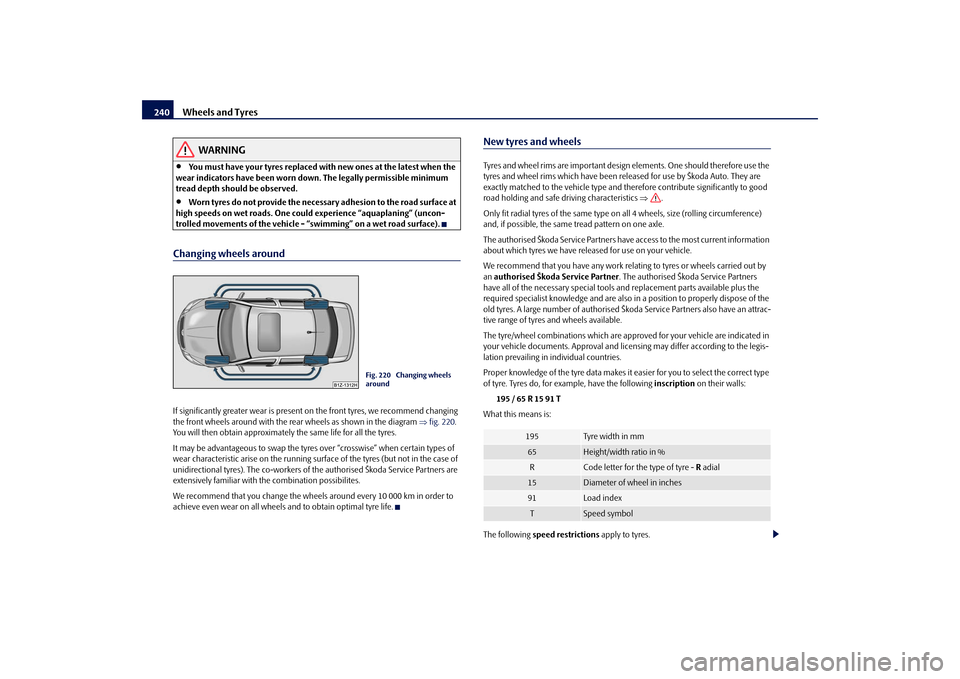
Wheels and Tyres
240
WARNING
•
You must have your tyres replaced with new ones at the latest when the
wear indicators have been worn do
wn. The legally permissible minimum
tread depth should be observed.•
Worn tyres do not provide the necessary adhesion to the road surface at
high speeds on wet roads. One could experience “aquaplaning” (uncon- trolled movements of the vehicle - “swimming” on a wet road surface).Changing wheels aroundIf significantly greater wear is present on
the front tyres, we recommend changing
the front wheels around with the rear wheels as shown in the diagram
⇒fig. 220
.
You will then obtain approximately the same life for all the tyres. It may be advantageous to swap the tyre
s over “crosswise” when certain types of
wear characteristic ar
ise on the running surface of the tyres (but not in the case of
unidirectional tyres). The co-workers of the authorised Škoda Service Partners are extensively familiar with the combination possibilites. We recommend that you change the wheels around every 10 000 km in order to achieve even wear on all wheels and to obtain optimal tyre life.
New tyres and wheelsTyres and wheel rims are important design elements. One should therefore use the tyres and wheel rims which have been re
leased for use by Škoda Auto. They are
exactly matched to the vehicle type and therefore contribute significantly to good road holding and safe driving characteristics
⇒
.
Only fit radial tyres of the same type on
all 4 wheels, size (rolling circumference)
and, if possible, the same tread pattern on one axle. The authorised Škoda Service Partners have access to the most current information about which tyres we have rele
ased for use on your vehicle.
We recommend that you have any work rela
ting to tyres or wheels carried out by
an authorised Škoda Service Partner
. The authorised Škoda Service Partners
have all of the nece
ssary special tools and replacem
ent parts available plus the
required specialist knowledge and are also in a position to properly dispose of the old tyres. A large number of authorised Škoda Service Partners also have an attrac- tive range of tyres and wheels available. The tyre/wheel combinations which are appr
oved for your vehicle are indicated in
your vehicle documents. Approval and lice
nsing may differ according to the legis-
lation prevailing in individual countries. Proper knowledge of the tyre data makes it easier for you to select the correct type of tyre. Tyres do, for exam
ple, have the following
inscription
on their walls:
195 / 65 R 15 91 T
What this means is: The following
speed restrictions
apply to tyres.
Fig. 220 Changing wheels around
195
Tyre w idt h in mm
65
Height/width ratio in %
R
Code letter for the type of tyre -
R adial
15
Diameter of wheel in inches
91
Load index
T
Speed symbol
se0.1.book Page 240 Frida
y, April 10, 2009 3:19 PM
Page 242 of 304

Wheels and Tyres
241
Using the system
Safety
Driving Tips
General Maintenance
Breakdown assistance
Technical Data
The date of manufacture
is als o stated o n the tyre wa ll (pos si bl y only on the
inside
of wheel):
DOT ... 20 09...
means, for example, that the tyre was ma
nufactured in the 20th week of the year
2009. Any
spare wheel
which differs from the tyres fitted to the vehicle (e.g. winter tyres
or low-profile tyres) should only be used for a short time in the event of a puncture and when adopting an appropriately cautious
style of driving. It should be replaced
as quickly as possible by a normal wheel.
WARNING
•
Only use those tyres or wheel rims which have been approved for your
model of Škoda Auto vehicle. Failure to observe this instruction will adversely affect the road safety of your vehicle - risk of accident! Approval and licencing of your vehicle on publ
ic roads may also become void as a
result.•
You must on no account drive at a hi
gher speed than is permissible for
your tyres - risk of an accident resulting from tyre damage and loss of control over your vehicle.•
Tyres which are 6 years old or more should only be fitted in exceptional
cases and when adopting an appropriately cautious style of driving.•
Never fit tyres which have already be
en used without having adequate
knowledge of their previous
history. Tyres age even if they have not been
used at all or only very little. A spare tyre must only be used in exceptional cases and only then when adopting an appropriately cautious style of driving.•
Do not, where possible, replace indivi
dual tyres but at least replace them
on both wheels of a given axle at the sa
me time. Always fit the tyres with the
deeper tread depth to the front wheels.
For the sake of the environment
Old tyres must be disposed
of in conformity with
the appropriate regulations.
Note
It is not normally possible to fit wheels
from other models of cars for technical
reasons. This may also apply in certain
circumstances to the wheels of the same
type of vehicle.Wheel boltsWheels and
wheel bolts
are matched to each other in terms of design. Each time
you fit other wheels - e.g. light alloy wheels
or wheels with winter tyres - you must
therefore also use the matching wheel bolts of the correct length and shape of spherical cap. This is essent
ial to ensure that the wheels are tightly fitted and that
the brake system operates properly. If you retrofit
wheel trims
(or have this done), please also ensure that an adequate
flow of air remains assured for cooling the brake system. The authorised Škoda Service Partners are instructed in the technical possibilities which exist regarding converting or retrofitting tyres, wheels and wheel trims.
WARNING
•
In case of incorrect treatment of th
e wheel bolts, the
wheel can loosen
when the car is moving - risk of accident!
Speed symbol
Permissible maximum speed
S
180 km/h
T
190 km/h
H
210 km/h
V
240 km/h
W
270 km/h
Y
300 km/h
WARNING (continued)
se0.1.book Page 241 Frida
y, April 10, 2009 3:19 PM
Page 243 of 304
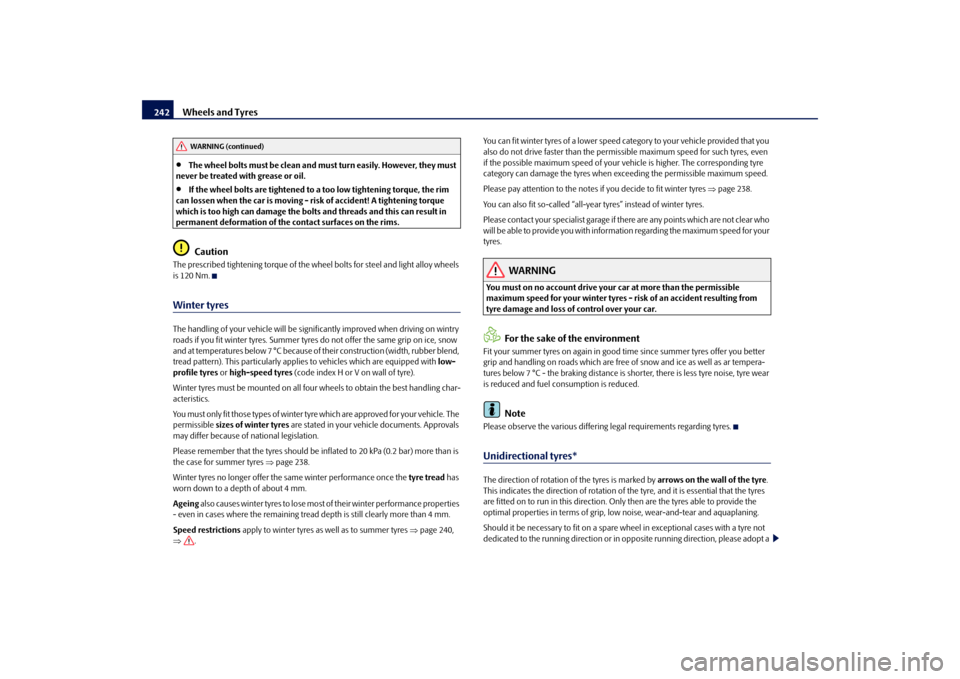
Wheels and Tyres
242
•
The wheel bolts must be clean and must
turn easily. However, they must
never be treated with grease or oil.•
If the wheel bolts are tightened to a too low tightening torque, the rim
can lossen when the car is moving - risk of accident! A tightening torque which is too high can damage the bolts and threads and this can result in permanent deformation of the contact surfaces on the rims.
Caution
The prescribed tightening torque of the wheel bolts for steel and light alloy wheels is 120 Nm.Winter tyresThe handling of your vehicle will be signi
ficantly improved when driving on wintry
roads if you fit winter tyres. Summer tyres do not offer the same grip on ice, snow and at temperatures below 7 °C because of
their construction (width, rubber blend,
tread pattern). This particularly applie
s to vehicles which
are equipped with
low-
profile tyres
or high-speed tyres
(code index H or V on wall of tyre).
Winter tyres must be mounted on all four
wheels to obtain the
best handling char-
acteristics. You must only fit those types of winter tyre
which are approved for your vehicle. The
permissible
sizes of winter tyres
are stated in your vehicle documents. Approvals
may differ because of
national legislation.
Please remember that the tyres should be in
flated to 20 kPa (0.2 bar) more than is
the case for summer tyres
⇒page 238.
Winter tyres no longer offer the
same winter performance once the
tyre tread
has
worn down to a depth of about 4 mm. Ageing
a l s o c a u s e s w i n t e r t y re s t o l o s e m o s t
of their winter performance properties
- even in cases where the remaining tread depth is still clearly more than 4 mm. Speed restrictions
apply to winter tyres as
well as to summer tyres
⇒page 240,
⇒
.
You can fit winter tyres of a lower speed ca
tegory to your vehicle provided that you
also do not drive faster than the permissible maximum speed for such tyres, even if the possible maximum speed of your ve
hicle is higher. The
corresponding tyre
category can damage the tyres when ex
ceeding the permissible maximum speed.
Please pay attention to the notes if
you decide to fit winter tyres
⇒page 238.
You can also fit so-called “all-year tyres” instead of winter tyres.Please contact your specialist garage if there are any points which are not clear who will be able to provide you with information regarding the maximum speed for your tyres.
WARNING
You must on no account drive your car at more than the permissible maximum speed for your winter tyres -
risk of an accident resulting from
tyre damage and loss of control over your car.
For the sake of the environment
Fit your summer tyres on again in good time since summer tyres offer you better grip and handling on roads which are free of snow and ice as well as ar tempera- tures below 7 °C - the braking distance is shorter, there is less tyre noise, tyre wear is reduced and fuel consumption is reduced.
Note
Please observe the various differing legal requirements regarding tyres.Unidirectional tyres*The direction of rotation of the tyres is marked by
arrows on the wall of the tyre
.
This indicates the direction of
rotation of the tyre, and it is essential that the tyres
are fitted on to run in this direction. On
ly then are the tyres able to provide the
optimal properties in terms of grip, lo
w noise, wear-and-tear and aquaplaning.
Should it be necessary to fit on a spare
wheel in exceptional cases with a tyre not
dedicated to the running direction or in o
pposite running direct
ion, please adopt a
WARNING (continued)
se0.1.book Page 242 Frida
y, April 10, 2009 3:19 PM
Page 244 of 304

Wheels and Tyres
243
Using the system
Safety
Driving Tips
General Maintenance
Breakdown assistance
Technical Data
cautious style of driving as the tyre is no
longer able to provide optimal grip and
handling in such a situation. This particul
arly important on wet roads. Please refer
to the notes
⇒page 247, “Spare wheel*”.
You should have the defective tyre replac
ed as soon as possible and restore the
correct direction of rotation on all tyresSnow chainsSnow chains must only be mounted on the front wheels. When driving on wintry roads, snow chains improve not only traction, but also the braking performance. For technical reasons, it is only permissi
ble to fit snow chains with the following
wheel/tyre combinations: Remove the
full wheel trims
if you wish to fit snow chains to the wheels.
Observe the national legal requirements relating to the maximum vehicle speed with snow chains.
WARNING
Please pay attention to the information in the supplied fitting instructions of the snow chain manufacturer.
Caution
You must take the chains off as soon as you drive on roads which are free of snow. They adversely affect the handling of your vehicle, damage the tyres and are rapidly destroyed.
Note
We recommend that you use snow chains
from the Škoda genuine accessories.
Wheel size
Depth (D)
Tyre s iz e
6J x 15
a)
a)Only fit snow chains with links an
d locks not larger than 15 mm.
47 mm
195/65
6.5J x 15
a)
50 mm
195/65
6J x 16
a)
50 mm
205/55
6J x 17
b)
b)Only fit snow chains with links
and locks not larger than 9 mm.
45 mm
205/50
se0.1.book Page 243 Frida
y, April 10, 2009 3:19 PM
Page 245 of 304
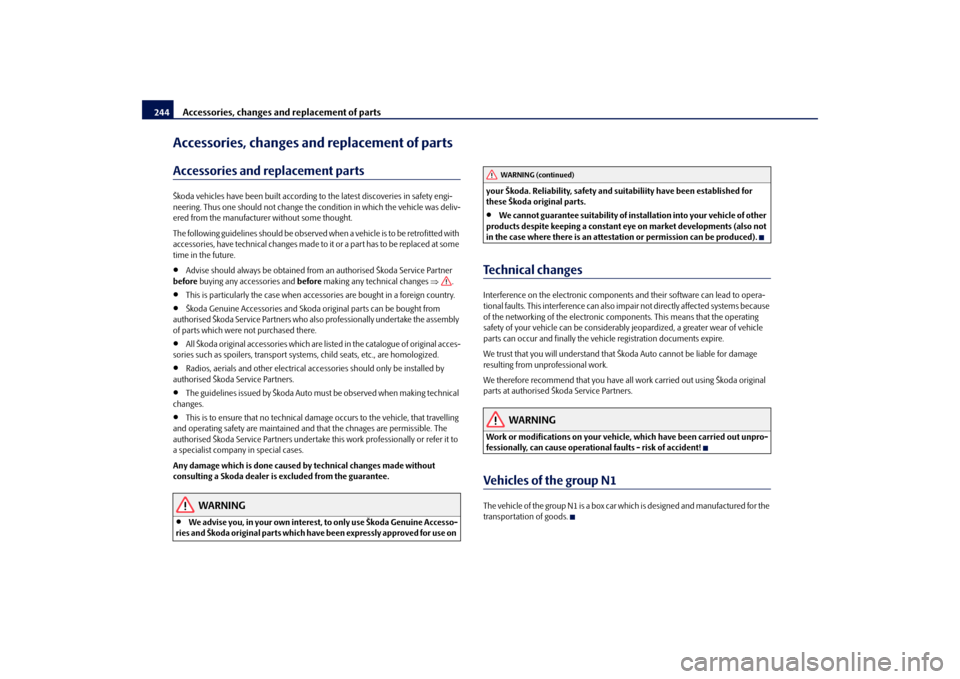
Accessories, changes and replacement of parts
244
Accessories, changes and replacement of partsAccessories and replacement partsŠkoda vehicles have been bu
ilt according to the latest discoveries in safety engi-
neering. Thus one should not change the
condition in which the vehicle was deliv-
ered from the manufacturer without some thought. The following guidelines should be observed when a vehicle is to be retrofitted with accessories, have technical chan
ges made to it or a par t has to be replaced at some
time in the future.•
Advise should always be obtained from an authorised Škoda Service Partner
before
buying any accessories and
before
making any technical changes
⇒
.
•
This is particularly the case when accessories are bought in a foreign country.
•
Škoda Genuine Accessories and Skoda original parts can be bought from
authorised Škoda Service Partners who also professionally undertake the assembly of parts which were not purchased there.•
All Škoda original accessories which are listed in the catalogue of original acces-
sories such as spoilers, transport systems, child seats, etc., are homologized.•
Radios, aerials and other electrical acce
ssories should only be installed by
authorised Škoda Service Partners.•
The guidelines issued by Škoda Auto must be observed when making technical
changes.•
This is to ensure that no technical damage
occurs to the vehicl
e, that travelling
and operating safety are maintained and that the chnages are permissible. The authorised Škoda Service Partners undertake this work professionally or refer it to a specialist company in special cases. Any damage which is done caused by technical changes made without consulting a Skoda dealer is
excluded from the guarantee.
WARNING
•
We advise you, in your own interest, to only use Škoda Genuine Accesso-
ries and Škoda original parts which have
been expressly approved for use on
your Škoda. Reliability, safety and suitabiliity have been established for these Škoda original parts.•
We cannot guarantee suitability of installation into your vehicle of other
products despite keeping a constant ey
e on market developments (also not
in the case where there is an attest
ation or permission can be produced).
Technical changesInterference on the electronic components and their software can lead to opera- tional faults. This interference can also im
pair not directly affected systems because
of the networking of the electronic co
mponents. This means that the operating
safety of your vehicle can
be considerably jeopardized,
a greater wear of vehicle
parts can occur and finally the vehi
cle registration
documents expire.
We trust that you will understand that Šk
oda Auto cannot be
liable for damage
resulting from unprofessional work. We therefore recommend that you have al
l work carried out using Škoda original
parts at authorised Škoda Service Partners.
WARNING
Work or modifications on your vehicle, which have been carried out unpro-fessionally, can cause operational faults - risk of accident!Vehicles of the group N1The vehicle of the group N1 is a box car
which is designed and manufactured for the
transportation of goods.
WARNING (continued)
se0.1.book Page 244 Frida
y, April 10, 2009 3:19 PM
Page 246 of 304

Breakdown assistance
245
Using the system
Safety
Driving Tips
General Maintenance
Breakdown assistance
Technical Data
Breakdown assistanceBreakdown assistanceFirst-aid box* and Warn
ing triangle* (Octavia)
The first-aid box* is attach
ed by a strap to the right-
hand side of the luggage
compartment The warning triangle can be at
tached to the trim panel of the rear wall with rubber
straps
⇒fig. 221
.
If you wish to equip your ve
hicle additionally with a warning triangle, please contact
a specialist garage.
Note
Pay attention to the use-by-date of the contents of the first-aid box.
First-aid box* and warning triangle* (Estate car)For vehicles of the type es
tate car the first-aid box and the warning triangle are
housed in a compartment on the right si
de in the luggage compartment. You can
open the compartment by turning the locks in the direction of arrow
⇒fig. 222
.
If you wish to equip your ve
hicle additionally with a warning triangle, please contact
a specialist garage.
Note
Pay attention to the use-by-date of
the contents of the first-aid box.
Fire extinguisher*The fire extinguisher is attached with straps in a holder under the driver seat. Please read carefully the
instructions which are atta
ched to the fire extin-
guisher.
Fig. 221 Placing of the warning triangle (Octavia)
Fig. 222 Placing of the warning triangle (Estate car)
se0.1.book Page 245 Frida
y, April 10, 2009 3:19 PM
Page 247 of 304
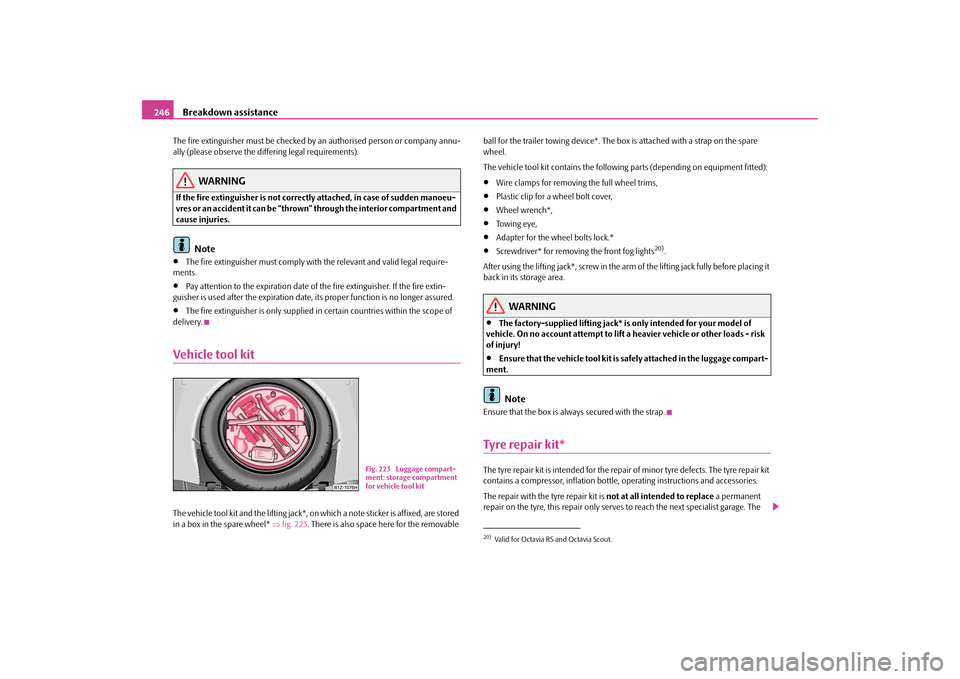
Breakdown assistance
246
The fire extinguisher must
be checked by an authoris
ed person or company annu-
ally (please observe the differing legal requirements).
WARNING
If the fire extinguisher is not correc
tly attached, in case of sudden manoeu-
vres or an accident it can be “thrown” through the interior compartment and cause injuries.
Note
•
The fire extinguisher must comply with
the relevant and valid legal require-
ments.•
Pay attention to the expiration date of the fire extinguisher. If the fire extin-
guisher is used after the expiration date,
its proper function is
no longer assured.
•
The fire extinguisher is only supplied in
certain countries within the scope of
delivery.Vehicle tool kitThe vehicle tool kit and the lifting jack*, on which a note sticker is affixed, are stored in a box in the spare wheel*
⇒fig. 223
. There is also space here for the removable
ball for the trailer towing device*. The bo
x is attached with a strap on the spare
wheel. The vehicle tool kit contains
the following parts (depen
ding on equipment fitted):
•
Wire clamps for removing the full wheel trims,
•
Plastic clip for a wheel bolt cover,
•
Wheel wrench*,
•
To w i n g e y e ,
•
Adapter for the wheel bolts lock.*
•
Screwdriver* for removing the front fog lights
20).
After using the lifting jack*, screw in the arm of the lifting jack fully before placing it back in its storage area.
WARNING
•
The factory-supplied liftin
g jack* is only intended for your model of
vehicle. On no account attempt to lift a heavier vehicle or other loads - risk of injury!•
Ensure that the vehicle tool kit is
safely attached in the luggage compart-
ment.
Note
Ensure that the box is alwa
ys secured with the strap.
Tyre repair kit*The tyre repair kit is intended for the repair of minor tyre defects. The tyre repair kit contains a compressor, inflation bottle, operating instructions and accessories. The repair with the
tyre repair kit is
not at all intended to replace
a permanent
repair on the tyre, this repair only serves
to reach the next specialist garage. The
Fig. 223 Luggage compart- ment: storage compartment for vehicle tool kit
20)Valid for Octavia RS and Octavia Scout.
se0.1.book Page 246 Frida
y, April 10, 2009 3:19 PM
Page 248 of 304

Breakdown assistance
247
Using the system
Safety
Driving Tips
General Maintenance
Breakdown assistance
Technical Data
repair can be undertaken on
the vehicle immediately.
Please read the attached
instructions carefully before the repair. The tyre repair kit is located in a textile ba
g. There is a velcro fastener on the under-
side of the bag, with which the bag is atta
ched to the floor covering of the luggage
compartment in such a way that the side of the bag rests on the right side of the luggage compartment and on the seat backrest.Spare wheel*The spare wheel lies in a well under the floor covering of the luggage compartment and is fixed in place using special screws
⇒fig. 224
.
Before removing the spare wheel, you must take out the box with the vehicle tool kit box
⇒page 246, fig. 223
.
One should check the inflation pressure in the spare wheel (at best when generally checking the tyre air pressures - see sign on the fuel filler flap
⇒page 238) to
ensure that the spare wheel is always ready to use. Temporary spare wheel A warning label displayed on the rim of the temporary spare wheel indicates that your vehicle is equipped with a temporary spare wheel. Please observe the following notes when driving with a temporary spare wheel:
•
After fitting on the wheel, the warning st
icker must not be concealed (e.g. by the
wheel trim).•
D o n o t d r i v e w i t h th i s s p a re w h e e l a t m o re th a n 8 0 k m / h - ri s k o f a c c i d e n t. Av o i d
accelerating at full throttle, sharp braking and fast cornering.•
The inflation pressure for this spare wheel is identical to the inflation pressure
of the standard tyres. The temporary spar
e wheel R 18 must have an inflation pres-
sure of 420 kPa (4.2 bar)!•
Use this spare wheel only to reach the nearest specialist garage as it is not
intended for continuous use.•
No other summer or winter tyres must
be mounted on the rim of the spare
wheel R 18.Changing a wheelPreliminary workThe following steps should be carried out before actually changing the wheel. – If it is necessary to change a wheel, park the vehicle as far away as
possible from the traffic flow. The place you choose should be
level
.
–Have
all the occupants get out.
While changing a wheel, the occu-
pants of the vehicle should not stan
d on the road (e.g. behind a crash
barrier).
– Apply the
handbrake
firmly.
–Engage
1st gear
or if your vehicle is fitted with an automatic gearbox,
position the
selector lever into position P
.
– If a trailer is coupled, uncouple it.– Take the
vehicle tool kit
⇒
page 246 and the
spare wheel*
⇒
page 247 out of the luggage compartment.
Fig. 224 Luggage compart- ment: Spare wheel
se0.1.book Page 247 Frida
y, April 10, 2009 3:19 PM
Page 249 of 304
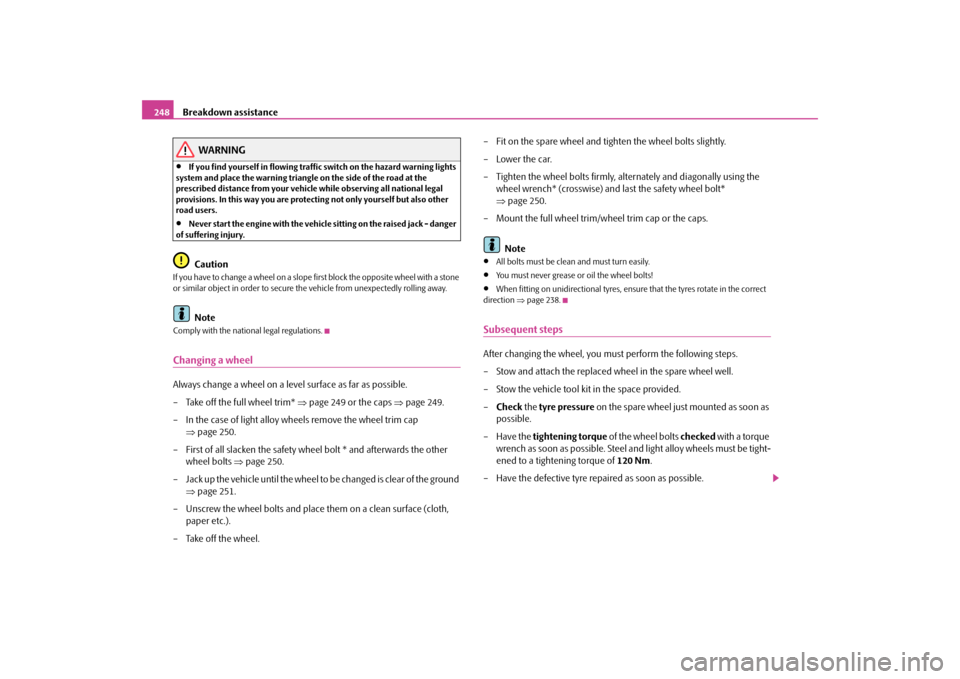
Breakdown assistance
248
WARNING
•
If you find yourself in flowing traffic switch on the hazard warning lights
system and place the warning triangle
on the side of the road at the
prescribed distance from your vehicl
e while observing all national legal
provisions. In this way you are protecting not only yourself but also other road users.•
Never start the engine with the vehicle
sitting on the raised jack - danger
of suffering injury.
Caution
If you have to change a wheel on a slope
first block the opposite wheel with a stone
or similar object in order to secure th
e vehicle from unexpectedly rolling away.
Note
Comply with the national legal regulations.Changing a wheelAlways change a wheel on a level surface as far as possible. – Take off the full wheel trim*
⇒
page 249 or the caps
⇒
page 249.
– In the case of light alloy wheels remove the wheel trim cap
⇒
page 250.
– First of all slacken the safety wh
eel bolt * and afterwards the other
wheel bolts
⇒
page 250.
– Jack up the vehicle until the wheel to
be changed is clear of the ground
⇒
page 251.
– Unscrew the wheel bolts and place them on a clean surface (cloth,
paper etc.).
– Take off the wheel.
– Fit on the spare wheel and tighten the wheel bolts slightly. – Lower the car. – Tighten the wheel bolts firmly, al
ternately and diagonally using the
wheel wrench* (crosswise) and last the safety wheel bolt* ⇒
page 250.
– Mount the full wheel trim/w
heel trim cap or the caps.
Note
•
All bolts must be clean
and must turn easily.
•
You must never grease or oil the wheel bolts!
•
When fitting on unidirectional tyres, ensure that the tyres rotate in the correct
direction
⇒page 238.
Subsequent stepsAfter changing the wheel, you must perform the following steps. – Stow and attach the replaced wheel in the spare wheel well. – Stow the vehicle tool kit in the space provided. –
Check
the
tyre pressure
on the spare wheel just mounted as soon as
possible.
– Have the
tightening torque
of the wheel bolts
checked
with a torque
wrench as soon as possible. Steel and light alloy wheels must be tight-ened to a tightening torque of
120 Nm
.
– Have the defective tyre repaired as soon as possible.
se0.1.book Page 248 Frida
y, April 10, 2009 3:19 PM
Page 250 of 304
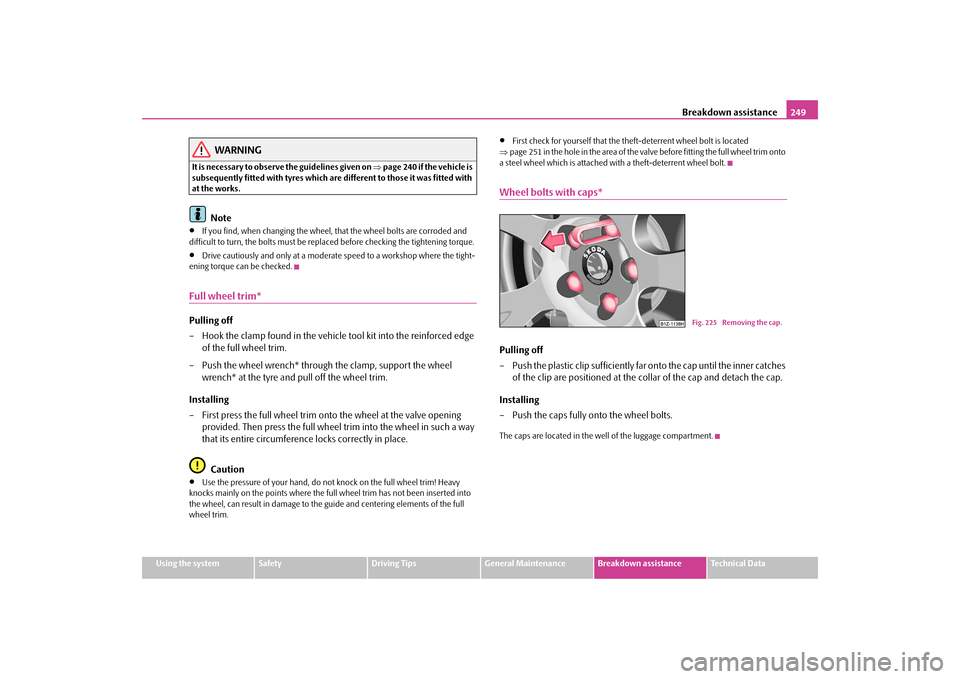
Breakdown assistance
249
Using the system
Safety
Driving Tips
General Maintenance
Breakdown assistance
Technical Data
WARNING
It is necessary to observ
e the guidelines given on
⇒page 240 if the vehicle is
subsequently fitted with tyres which are different to those it was fitted with at the works.
Note
•
If you find, when changing the wheel,
that the wheel bolts are corroded and
difficult to turn, the bolts mu
st be replaced before chec
king the tightening torque.
•
Drive cautiously and only at a moderate speed to a workshop where the tight-
ening torque can be checked.Full wheel trim*Pulling off – Hook the clamp found in the vehicle tool kit into the reinforced edge
of the full wheel trim.
– Push the wheel wrench* through the clamp, support the wheel
wrench* at the tyre and pull off the wheel trim.
Installing – First press the full wheel trim onto the wheel at the valve opening
provided. Then press the full wheel trim into the wheel in such a way that its entire circumference locks correctly in place. Caution
•
Use the pressure of your hand, do not knock on the full wheel trim! Heavy
knocks mainly on the points where the full
wheel trim has not been inserted into
the wheel, can result in damage to the guide and centering elements of the full wheel trim.
•
First check for yourself that the theft-deterrent wheel bolt is located
⇒ page 251 in the hole in the area of the valve before fitting the full wheel trim onto a steel wheel which is attached with a theft-deterrent wheel bolt.Wheel bolts with caps*Pulling off – Push the plastic clip sufficiently fa
r onto the cap until the inner catches
of the clip are positioned at the collar of the cap and detach the cap.
Installing – Push the caps fully onto the wheel bolts.The caps are located in the we
ll of the luggage compartment.
Fig. 225 Removing the cap.
se0.1.book Page 249 Frida
y, April 10, 2009 3:19 PM